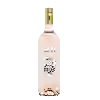
Winery CharoussetCôteaux d'Aix-en-Provence Rosé
This wine generally goes well with
The Côteaux d'Aix-en-Provence Rosé of the Winery Charousset is in the top 0 of wines of Coteaux d'Aix-en-Provence.
Details and technical informations about Winery Charousset's Côteaux d'Aix-en-Provence Rosé.
Discover the grape variety: Sweet Sapphire
Intra-specific cross between Beitamouni and C22-121 obtained in 2004 by David Cain at the I.F.G. of Bakersfield in California (United States). Its cultivation started in 2007. It is already known in the United States, Brazil, Australia, South Africa ... almost unknown in France. It should be noted that this variety is very much in demand in China, where it represents an important market.
Informations about the Winery Charousset
The Winery Charousset is one of of the world's greatest estates. It offers 3 wines for sale in the of Coteaux d'Aix-en-Provence to come and discover on site or to buy online.
The wine region of Coteaux d'Aix-en-Provence
Côteaux d'Aix-en-Provence is one of the main French appellations in the Provence wine region, located in the extreme southeast of the country. It is the second largest appellation in the region, with about 4,000 hectares North and west of Aix-en-Provence - the town from which it takes its name. The area also bears the tiny title of AOCPalette. The Côteaux d'Aix-en-Provence appellation was first introduced as a VDQS in 1956, having been informally known as Côteaux du Roy René (René d'Anjou being a 15th century French king famous for his love of wine and the Vine).
The wine region of Provence
Provence is a wine region in the far southeast of France, best known for the quality (and quantity) of its rosé wines and for its Warm, mild Climate. The modernization that is taking place in many of the traditional wine regions of southern France has not yet taken place to the same extent in Provence, but there are Clear signs of change. The region's Grape varieties, in particular, have come under scrutiny in recent decades. Traditional varieties such as Carignan, Barbaroux (Barbarossa from Sardinia) and Calitor are being replaced by more commercially viable varieties such as Grenache, Syrah and even Cabernet Sauvignon.
The word of the wine: Côte des Bar
This is the name given to the vineyards of the Aube, which are closer to Burgundy, and some of the wines produced here bear witness to this proximity. The pinot noir dominates, the meunier is practically absent. Two crus have become references: Riceys, where a rosé without bubbles is also produced, and Montgueux near Troyes, renowned for its Chardonnay.






